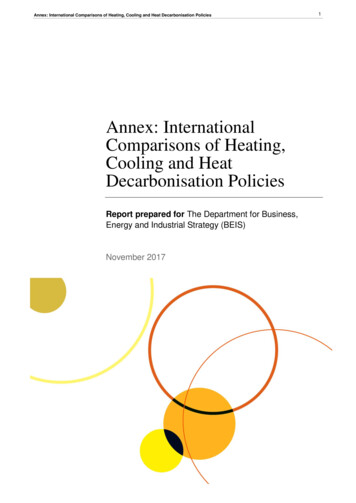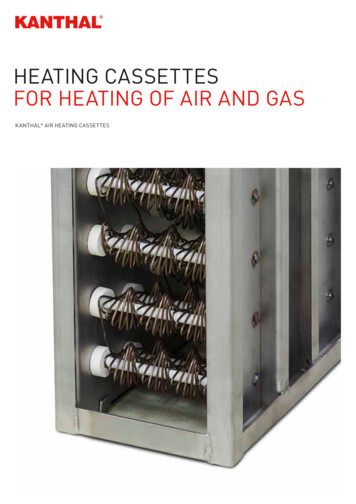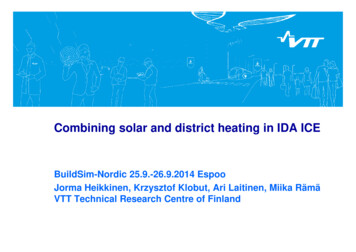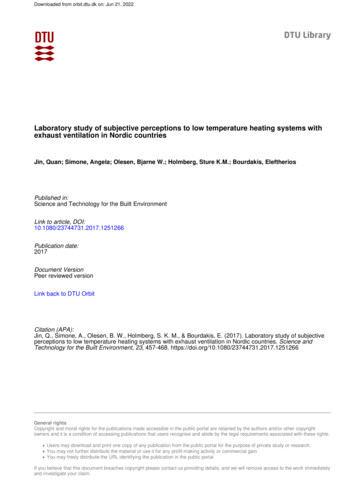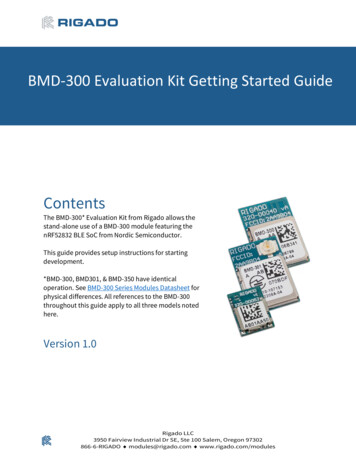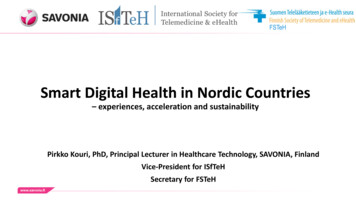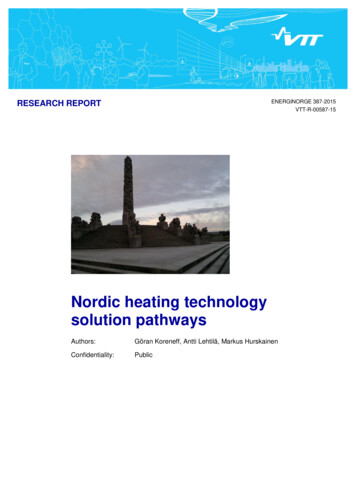
Transcription
ENERGINORGE 387-2015VTT-R-00587-15RESEARCH REPORTNordic heating technologysolution pathwaysAuthors:Göran Koreneff, Antti Lehtilä, Markus HurskainenConfidentiality:Public
EnergiNorge publikasjonsnr. 387-2015RESEARCH REPORT VTT-R-00587-151 (43)Report’s titleNordic heating technology solution pathwaysCustomer, contact person, addressOrder referenceEnergi Norge As, Solgun Furnes,Postboks 7184 Majorstuen,0307 OsloProject nameProject number/Short name89025 Nordic heating technology solution pathwayVTT-V-89025-14/ 101843-15Author(s)PagesGöran Koreneff, Antti Lehtilä, Markus Hurskainen43KeywordsReport identification codedistrict heating, CHP, heat production technologyVTT-R-00587-15/ EnergiNorge 3872015 (ISBN: 978-82-436-1006-4)SummaryThe report presents the results of a sub-study of district heat production technologydevelopment for the Norwegian Flexelterm research program. The objective is to describepotential and likely technology changes on the production side, including storages, in the next20-30 years that can affect the role of district and area heating systems in the Nordiccountries Norway, Sweden, Denmark and Finland. As the Nordic countries are quite differentand have their own idiosyncrasies, a short overview of each of them is given.Heating network system developments can and do affect how and when district heat isproduced and by whom. Technological aspects such as heat storages and low temperaturenetworks are looked at. The main focus, however, concerns heat production technologies ona district and area heating scale from renewable energy sources, primarily biomass and heatpumps, but also other technologies such as solar and deep geothermal heat. Quantitativeestimates of energy efficiencies and investment costs are the primary target. Whereas amultitude of references for the cost items and efficiencies power production are to be found,detailed estimates for combined heat and power or heat-only boilers are much harder tocome by.Technology changes are to be expected, but they are not only technology or cost driven but,more often than not, politically driven. What is more, there is often not just one district heatingtechnology that dominates, but a multitude, and each Nordic country will favour some morethan others because of local conditions, market structure and historical development.Bio-CHP will increase either through the market or by political push. Also, all kinds ofdistributed generation and area networks are expected to increase in locations where theprices of heat and/or electricity are high, such as Denmark.ConfidentialityPublicEspoo 29.3.2015Written byReviewed byAccepted byGöran KoreneffProject managerTiina KoljonenTeam managerTuula MäkinenHead of research areaVTT’s contact addressVTT. P.O.Box 1000, 02044 VTTDistribution (customer and VTT)Solgun Furnes, EnergiNorge; VTT. The report is also delivered electronically and it is alsoavailable on VTT’s internet site as well as on EnergiNorge’s internet site.The use of the name of the VTT Technical Research Centre of Finland (VTT) in advertising or publication in part ofthis report is only permissible with written authorisation from the VTT Technical Research Centre of Finland.
EnergiNorge publikasjonsnr. 387-2015RESEARCH REPORT VTT-R-00587-152 (43)PrefaceThe report presents the results of a sub-study of district heat production technologydevelopment for the Norwegian Flexelterm research program, here represented by ErikTrømborg from the Institutt for naturforvaltning, NMBU, via EnergiNorge, represented bySolgun Furnes. This VTT research report 00587-15 is published in the EnergiNorgepublication series with the number 387-2015.The authors wish to thank the large group of experts at VTT who shared their knowledgeand/or who helped by commenting the report: Kari Sipilä, district heating systems, MiikaRämä, heat storages, Rami Niemi, geothermal heat, and Veli-Pekka Heiskanen, Janne Kärki,Antti Arasto and Jani Lehto, bioenergy.29.3.2015Göran Koreneff
EnergiNorge publikasjonsnr. 387-2015RESEARCH REPORT VTT-R-00587-153 (43)ContentsPreface. 2Contents . 3Abbreviations . 51. Introduction . 61.1 Research target: foreseeable changes in Nordic heat network related technologies . 61.2 Research outline . 61.3 Limitations to the research scope . 62. Status quo of area/district heating systems in Nordic countries . 72.1 Sweden . 92.1.1 Status quo and idiosyncrasies. 92.1.2 Assessment of future heat production by technology . 102.2 Denmark . 102.2.1 Status quo and idiosyncrasies. 102.2.2 Assessment of future heat production by technology . 112.3 Finland . 152.3.1 Status quo and idiosyncrasies. 152.3.2 Assessment of future heat production by technology . 162.4 Norway . 172.4.1 Status quo and idiosyncrasies. 172.4.2 Assessment of future heat production by technology . 173. Network and system related technology changes . 193.1 Heat storages . 193.1.1 Power/heat system related demands and possibilities for flexibility . 193.1.2 Heat storage technologies . 203.2 New heating networks . 233.2.1 Low temperature heating networks . 233.2.2 Smart heat networks . 234. Heat production technology developments . 244.1 Bio CHP . 254.1.1 Status quo of costs and efficiencies . 254.1.2 Foreseeable technology changes . 284.2 Biomass heat-only boilers . 314.2.1 Status quo of costs and efficiencies . 314.2.2 Foreseeable technology changes . 324.3 Large scale heat pumps. 324.3.1 Status quo of costs and efficiencies . 324.3.2 Foreseeable technology changes . 334.4 Other production alternatives . 334.4.1 Large scale solar heating . 334.4.2 Waste heat. 344.4.3 Deep direct geothermal heat . 34
EnergiNorge publikasjonsnr. 387-2015RESEARCH REPORT VTT-R-00587-154 (43)4.4.4 Electric boilers . 364.4.5 Hydrogen systems and/or fuel cells . 364.4.6 Nuclear CHP . 384.5 Other factors influencing technologies, availabilities and costs . 384.5.1 The competition for biomass . 384.5.2 EU Directives for medium-sized combustion plant emissions . 384.5.3 CO2 and RES targets . 395. Summary and conclusions . 39References . 40
EnergiNorge publikasjonsnr. 387-2015RESEARCH REPORT VTT-R-00587-155 (43)AbbreviationsBFBBubbling fluidised bedBTESBorehole thermal energy storageCCGTCombined cycle gas turbineCCSCarbon capture and storageCFBCirculating fluidised bedCHPCombined heat and powerCOPCoefficient of performanceCSPConcentrating solar [thermal] powerDHDistrict heatingETSEuropean trade systemEUAEmission unit allowancesICEInternal combustion engineIEDEU Industrial emissions directiveIGCCIntegrated gasification combined cycleMCPMedium-sized combustion plantMWMegawattMSWMunicipal solid wasteORCOrganic ranking cyclePEMFCProton exchange membrane fuel cellRDFRefuse-derived fuelRESRenewable energy sourcesRES-EElectricity from renewable energy sourcesSOFCSolid oxide fuel cellSPFSeasonal performance factorUTESUnderground thermal energy storages
EnergiNorge publikasjonsnr. 387-2015RESEARCH REPORT VTT-R-00587-156 (43)1. Introduction1.1Research target: foreseeable changes in Nordic heat networkrelated technologiesThe objective is to describe potential and likely technology changes on the production side,including storages, in the next 20–30 years that can affect the role of district and areaheating systems in the Nordic countries Norway, Sweden, Denmark and Finland.As these findings are going to be used in energy models such as Balmorel, quantitativeestimates of energy efficiencies and investment costs, where available, are the primarytarget. The main areas of interest are biomass and CHP, heat pumps and thermal storages.Fossil technologies are not of interest.1.2Research outlineAs the Nordic countries are quite different and have their own idiosyncrasies, a shortoverview of them is given. Finland, Sweden and Denmark have strong DH penetrations inurban areas and the focus is on them, especially as the recipient of the report has a muchbetter knowledge of the Norwegian situation. Some trends are visible while some futuretrends can be anticipated based on the knowledge of the current situation.Heating network system developments can and do affect how and when district heat isproduced and by whom. More technological aspects thereof are looked at here: heatstorages and low temperature networks.The main focus, however, is on heat production technologies from renewable energysources, primarily biomass and heat pumps, on a district and area heating scale. Othertechnologies such as solar and deep geothermal heat are also studied, but not as intensely.Generally used sources such as the International Energy Agency (IEA 2010), theInternational Renewable Energy Agency (IRENA 2015), the Annual Energy Outlook of theUS Energy Information Administration (EIA AEO 2014) and the World energy council (WEC2013) were studied, but they are mainly concerned with the costs of power generation.Where CHP is included, not enough information is given about the plants and what isincluded in the costs and the overall level of detail is not is not good enough for the targethere.1.3Limitations to the research scopeDistrict heating (DH) is here understood to mean larger heating systems involving more thana handful of end-users. District heating systems exist in most larger Nordic cities and also inmany smaller municipalities. Area heating is in this report seen as very small and localdistrict heating systems with an annual demand of at least 1 GWh. Micro-scale CHP andboilers are outside the scope of this study.District and area heating will be affected by technology developments on the end-user side.One of the main factors already eating away at DH demand is the increased use of heatpumps, not only in DH houses but also as a means of switching away from DH. With newlow-energy building codes coming into effect in 2020 in the EU, the heat demand is muchlower in new houses, which means that low investment cost solutions are strong contenders.Other technological advancements concern auxiliary heating sources, for example solarthermal collectors, and comfort heating sources such as electric floor heating, for example inbathrooms. End-user technologies are not part of this study.
EnergiNorge publikasjonsnr. 387-2015RESEARCH REPORT VTT-R-00587-157 (43)Industrial heat production is not part of this study. As fossil based technologies are on theirway out in Europe and in the Nordic countries, almost no focus is put on them either.2. Status quo of area/district heating systems in Nordic countriesDistrict heating has a strong market position in Denmark, Sweden and Finland, and generallyit will remain so, but the demand for DH will start to decrease towards 2030–2050. Currentcustomers will mostly remain; however, their loads may change in line with energy efficiencyimprovements in both old and new houses, both in terms of insulation and reuse of heat, andthe increased use of air heat pumps, secondary electric heating (bathroom floors, incomingair preheater) or solar heating as auxiliary heat sources.DH will retain one of its most competitive features for the customer: it is a very carefree heatsupply. DH is also able to utilise different fuels and production modes such as CHP andboilers, industrial or tertiary (i.e. service) sector waste heat sources, and heat from wastemaking it very competitive locally. Although end-users have the possibility to have CHPthemselves, the costs of micro- or mini-scale CHPs are much higher than those of DH-sizedunits.The prospects for DH systems differ country by country. Taxation and subsidies play a bigrole in the formation of the prospects, but all kind of regulations, political decisions on EU,national or regional levels, and local market aspects are also strongly involved. In Finland, apossible future EU-based change in the renewable energy status of forest residues anddifficulties in getting licenses for new peat production areas might affect the profitability ofmost inland DH networks, as they are more and more relying on peat and local forest-basedbiomass. In Sweden (and to a small degree in Finland), high DH prices in some networks arealready driving end-users to switch to heat pumps.CHP itself is already an important factor in the Nordic power system. Figure 1 shows theshare of CHP of the gross electricity production in each of the countries. Denmark has thehighest share followed by Finland, where, however, almost as much electricity is receivedfrom industrial CHPs as from DH CHPs. The share of CHP is increasing, especially thanks togreen certificates. The importance of CHPs for Norway’s electricity production is almostnegligible.Figure 1. The share of CHP of gross electricity production in the Nordic countries.(Datasource: Eurostat 2014)
EnergiNorge publikasjonsnr. 387-2015RESEARCH REPORT VTT-R-00587-158 (43)VTT uses a global model, TIMES-VTT1, to assess, among other things, the developments inthe heating sector in the Nordic countries. The TIMES-VTT model is a partial equilibriummodel of the global energy system based on linear optimization. Assuming efficient marketsand perfect foresight, the model calculates a market equilibrium solution through costminimisation for energy production, conversion and end-use under specified energy demandprojections, technology assumptions and policies (e.g. targets for emissions levels or globaltemperature). This is done on a global scale using 15 areas, where each of the Nordiccountries of this study comprises one area. The model base year is 2005 and the results arecalibrated for the year 2010 using mainly IEA statistics2 (see e.g. IEA 2015). The calibrationitself was not part of this study. Even though the target is to have the results match therealised data, there will be discrepancies. All individual results will not exactly match thestatistics; especially this is noteworthy for the relatively small Norwegian district heatingsector. And there are classification differences between the model and the statistics, forexample for industrial and district heat, especially if compared to statistics other than thosefrom the IEA. The model results for Finland have been calibrated extensively, also usingnational sources; this is less the case for the other countries. The EU 20-20-20 targets aswell as the EU 2030 targets will be met. For EU countries this means that the nationalrenewable energy targets as well as the greenhouse gas targets for the non-trade sectorswill be met. Norwegian and Swedish electricity certificate targets will also be met. Thegreenhouse targets of the emission trading system will also be met. Figure 2 shows how thedivision (bioenergy, oil and gas, district heat, electricity and other) of the final energy forheating is estimated to develop from 2010 to 2050 in 10 year steps according to TIMES-VTT.The overall heating demand is estimated to decrease by nearly 40%, but district heating willremain a strong competitor.Figure 2. Estimated heating development in the Nordic countries 2010–2050 according toTIMES-VTT.1The TIMES-VTT energy system model is based on the TIMES energy system modelling frameworkdeveloped under the IEA Energy Technology Systems Analysis Programme (ETSAP) and the globalETSAP-TIAM model (Loulou et al. 2005, Loulou & Labriet 2007).2 IEA energy statistics differ from Eurostat statistics, which in turn differ from national statistics, andone of the main differences is how industrial CHP is handled and the fuels allocated. IEA statistics areusually delivered by national statistics bureaus just as EU statistics and national statistics.
EnergiNorge publikasjonsnr. 387-2015RESEARCH REPORT VTT-R-00587-159 (43)Energy efficiency development of the building sectors, that is the change in the specific heatdemand, in the Nordic countries is expected to follow the separately modelled Finnish rate.The building volume itself is dependent on the population growth.2.1Sweden2.1.1Status quo and idiosyncrasiesDistrict heating is very popular and widespread in Sweden. According to Eurostat (2014),derived heat (here district heating) net production was 54.6 TWh and final consumption 52.3TWh in 2012.Most of the DH came from thermal power plants, 49.0 TWh, including 5.2 TWh from flue gascondensation. Heat pumps delivered 5.8 TWh and electric boilers 0.2 TWh. Waste heat fromindustry is 4.8 TWh, bringing the total production up to 59.8 TWh, a higher value thanEurostat gave. (SCB 2013)It appears that heat from flue gas condensation is not included in the Eurostat statistics,which therefore also give delivery losses of only 2.2 TWh.CHP production, of which over 70% is bio-CHP (IEA 2011), in DH networks is a very recentdevelopment. There was no need for CHP electricity as Sweden had ample nuclear andhydro based production, but with an open Nordic market and the introduction of greencertificates,3 CHP and especially bio/waste-CHP has been successful. Waste accounted forabout 10 TWh of DH heat (Eurostat 2014). The gas network is very restricted in Sweden andcomprises only the South-West coastal area with, e.g., Malmö and Gothenburg. The only(deep) geothermal heat is utilised at Lund,4 where 20 C lukewarm water is pumped up froma depth of 700 meters and then used as input for heat pumps. There are also DH marketdevelopments; for example, as of 2012 Stockholm has opened a heat test market, wherelarge end-users, e.g. stores and server halls, can deliver excess heat to the network.The division of heating sources for residential and tertiary sectors between 2000 and 2012are presented in Figure 3. The market share of DH is constantly increasing in both sectors atthe expense of oil heating. The DH market share is strong in the tertiary sector (the servicesector is usually located in cities and local centres). That said, district heating is facing toughcompetition in some networks. Energy component based tariffs can be seen as expensiveand end-users have started to convert from DH to ground source or to install auxiliary air/airheat pumps.3Peat is also eligible for green certificates in rmi/4
EnergiNorge publikasjonsnr. 387-2015RESEARCH REPORT VTT-R-00587-1510 (43)Figure 3. Residential (left) and tertiary sector heat sources in Sweden 2000–2012. Here heatstands for purchased heat, i.e. district or area heat. Data source: Enerdata 2014.2.1.2Assessment of future heat production by technologyAccording to TIMES-VTT results, see Figure 4, DH is estimated to decrease towards 2050.CHP production is also estimated to decrease in the next five years. The reason is that theincrease of hydro, wind and nuclear capacity in the Nordic countries up to 2020 isdiminishing the need for CHP produced electricity.Figure 4. Assessment of the development of DH in Sweden by TIMES-VTT. HPL stands forheat-only boiler. Bio includes waste, coal includes peat and elec(tricity) includes heat pumps.2.2Denmark2.2.1Status quo and idiosyncrasiesDistrict heating is very popular and widespread in Denmark. According to Eurostat (2014),derived heat (here district heating) net production was 36.8 TWh and final consumption 30.0TWh in 2012.
EnergiNorge publikasjonsnr. 387-2015RESEARCH REPORT VTT-R-00587-1511 (43)Most of the DH came from CHP plants, 27.5 TWh. As for energy sources, nearly 7 TWh wasfrom waste, 11 TWh from solid biofuels (mainly straw), 9 TWh from both coal and naturalgas. (Eurostat 2014)The large coal CHP units in Denmark are traditional condensing power plants that have beenconverted to extraction power plants by law and their main task is still the production ofelectricity, which is why electricity from CHP plants is only partly CHP electricity; otherwise itis condensing power production. If the old extraction units are far away from the actual heatconsumption, heat can be transferred to the DH networks through high temperature (e.g.120 C) pipes.The division of heating sources for residential and tertiary sectors between 2000 and 2012 ispresented in Figure 5. The market share of DH is slowly increasing in both sectors at theexpense of oil heating although biomass is showing a much stronger increase in theresidential sector. The DH market share is strong in the tertiary sector (the service sector isusually located in cities and local centres).Figure 5. Residential (left) and tertiary sector (right) heat sources in Denmark 2000–2012.Here heat stands for purchased heat, i.e. district or area heat. Data source: Enerdata 2014.2.2.2Assessment of future heat production by technologyAccording to TIMES-VTT results, see Figure 6, DH is estimated to decrease. CHP productionis also estimated to decrease in the next five years before increasing again. The reason isthat the increase of hydro, wind and nuclear capacity in the Nordic countries up to 2020 isdiminishing the need for CHP produced electricity.
EnergiNorge publikasjonsnr. 387-2015RESEARCH REPORT VTT-R-00587-1512 (43)Figure 6. Assessment of the development of DH in Denmark by TIMES-VTT. HPL stands forheat-only boiler. Bio includes waste, coal includes peat and elec(tricity) includes heat pumps.The market share (based on floor area) of DH is expected to keep rising, see Figure 7, as isthe floor area. Small scale district heating, or area heating as we have used in this report, isexpected to grow from 2015 onwards but the share will remain low. Energy efficiencyimprovements make the TIMES-VTT heat demand decrease scenario plausible even if thebuilding stock is expanding. As Denmark is planning to have half the country’s powerproduction come from wind in the near future, the balancing of the power system becomesmore and more crucial. District heating with CHP, electric boilers and heat pumps as well asheat storages will be essential in that task.
EnergiNorge publikasjonsnr. 387-2015RESEARCH REPORT VTT-R-00587-1513 (43)Figure 7. The market share of heating sources for the floor area of the Danish building stock1980-2050 according to a strategic study by Aalborg University and Ramboll. (Source:EuroHeat&Power 2012b)As Denmark has high electricity and DH prices, alternative renewable energy based DHsolutions such as geothermal or solar heat are quite popular.The deeper geothermal resources in Denmark are mainly located in to two deep, lowenthalpy sedimentary basins, the Norwegian–Danish Basin and the North German Basin.Comprehensive research based on seismic and well data, primarily from previoushydrocarbon exploration campaigns, has shown that the fill of the Norwegian–Danish Basincontains several formations with sandstones of sufficient quality and temperature to serve asgeothermal reservoirs. However, Denmark has no pronounced high-temperature hot spotareas (Mahler et al. 2013).With current technology and cost levels, geothermal deep heat has good potential mainly inAalborg, but all of Denmark is full of potential, but low enthalpy, geothermal heat resourcesas can be seen in Figure 8.In Denmark there are three geothermal heat plants supplying DH networks: in CopenhagenMargretheholm, Thisted and the most recent in Sønderborg. More than 10 geothermal DHplants are planned to be built including an installation in Greater Copenhagen with expectedcapacity of 65 MW th. (Geo DH 2014a)
EnergiNorge publikasjonsnr. 387-2015RESEARCH REPORT VTT-R-00587-1514 (43)Figure 8. Deep geothermal heat sources according to EU project Geo DH Europe (GeoDH2013, 2014a). Red areas have temperatures above 90 C at 2 000 m depth and green areashave other reservoir potentials. Red spots indicate DH networks using geothermal heat.Source: Interactive map at http://loczy.mfgi.hu/flexviewer/geo dh/Solar district or area heating is quite widespread in Denmark, see Figure 9. Solar is stored inseasonal heat storages, i.e. borehole clusters and pit storages. Denmark has also what itcalls smart district heating consisting of solar collectors, heat storages, heat pumps andCHP.
EnergiNorge publikasjonsnr. 387-2015RESEARCH REPORT VTT-R-00587-1515 (43)Figure 9. Existing and planned solar district heating in Denmark (Source: EuroHeat&Power2012a)2.3Finland2.3.1Status quo and idiosyncrasiesDistrict heating is very popular and widespread in Finland. According to Eurostat (2014),derived heat (here a large chunk not district heating) net production was 54.5 TWh and finalconsumption 49.8 TWh in 2012. As derived heat means heat produced and sold, this canalso include industrial CHP, if the owner of the production facility is not the industry partner.Several CHPs produce both DH and industrial steam.The actual production and consumption of DH in Finland in 2012 was 37.1 TWh and 34.0TWh, respectively. Of the production, 69.2%, less than normal, was CHP production and themain fuels were natural gas (27%), coal (25%), peat (16%) and forest wood (14%). There are168 towns with district heating included in the statistics and 66 DH CHP plants.(Energiateollisuus 2013)Most of the DH production takes place in large fossil fuel fired backpressure CHP units incities, but on the other hand, the main fuel in most DH networks is wood and other biofuels,followed by peat. More rural or smaller DH networks find it easier to fulfil their heat needswith local forest wood and peat while cities generally depend on fossil fuels. The gas networkcomprises only the Southern part of Finland. Aside from a few exceptions, MSW boilers are avery recent phenomena in Finland.
EnergiNorge publikasjonsnr. 387-2015RESEARCH REPORT VTT-R-00587-1516 (43)The division of heating sources for residential and tertiary sectors between 2000 and 2012 ispresented in Figure 10. The market share of DH in the residential sector has been quiteconstant, where wood and electricity (including heat pumps) have increased their share. Themarket share of DH in the tertiary sector has a growing trend.Figure 10. Residential (left) and tertiary sector (right) heat sources in Finland 2000–2012.Here heat stands for purchased heat, i.e. district or area heat. Data source: Enerdata 2014.2.3.2Assessment of future heat production by technologyAccording to TIMES-VTT results, see Figure 11, DH as a whole and CHP heat are estimatedto decrease towards 2050. Heat from bio-CHP is expected to increase towards 2050 andheat from bio heat-only boilers is expecte
way out in Europe and in the Nordic countries, almost no focus is put on them either. 2. Status quo of area/district heating systems in Nordic countries District heating has a strong market position in Denmark, Sweden and Finland, and generally it will remain so, but the demand for DH will start to decrease towards 2030-2050. Current
